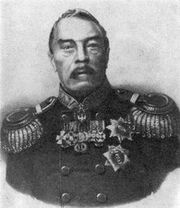
Pyotr Gorchakov
Encyclopedia

Imperial Russian Army
The Imperial Russian Army was the land armed force of the Russian Empire, active from around 1721 to the Russian Revolution of 1917. In the early 1850s, the Russian army consisted of around 938,731 regular soldiers and 245,850 irregulars . Until the time of military reform of Dmitry Milyutin in...
general from the Gorchakov
Gorchakov
Gorchakov, or Gortchakoff , is a Russian princely family of Rurikid stock, descended from the Rurikid sovereigns of Peremyshl, Russia.-Aleksey Gorchakov:The family first achieved prominence during the reign of Catherine II...
family of Russian nobility
Russian nobility
The Russian nobility arose in the 14th century and essentially governed Russia until the October Revolution of 1917.The Russian word for nobility, Dvoryanstvo , derives from the Russian word dvor , meaning the Court of a prince or duke and later, of the tsar. A nobleman is called dvoryanin...
.
He served under Mikhail Kamensky
Mikhail Kamensky
Count Mikhail Fedotovich Kamensky was a Russian Field Marshal prominent in the Catherinian wars and the Napoleonic campaigns....
and Mikhail Kutuzov in the campaign against Turkey, and afterwards against France in 1813–1814. In 1820 he suppressed an insurrection in the Caucasus
Caucasus
The Caucasus, also Caucas or Caucasia , is a geopolitical region at the border of Europe and Asia, and situated between the Black and the Caspian sea...
, for which service he was raised to the rank of major-general. In 1828–1829 he fought under Prince Peter von Wittgenstein against the Turks, won an action at Aidos, and signed the treaty of peace
Treaty of Adrianople
The Peace Treaty of Adrianople concluded the Russo-Turkish War, 1828-1829 between Russia and the Ottoman Empire. It was signed on September 14, 1829 in Adrianople by Russia's Count Alexey Fyodorovich Orlov and by Turkey's Abdul Kadyr-bey...
at Adrianople. In 1839 he was made governor of Eastern Siberia
Siberia
Siberia is an extensive region constituting almost all of Northern Asia. Comprising the central and eastern portion of the Russian Federation, it was part of the Soviet Union from its beginning, as its predecessor states, the Tsardom of Russia and the Russian Empire, conquered it during the 16th...
, and in 1851 retired into private life.
When the Crimean War
Crimean War
The Crimean War was a conflict fought between the Russian Empire and an alliance of the French Empire, the British Empire, the Ottoman Empire, and the Kingdom of Sardinia. The war was part of a long-running contest between the major European powers for influence over territories of the declining...
broke out he offered his services to the emperor Nicholas
Nicholas I of Russia
Nicholas I , was the Emperor of Russia from 1825 until 1855, known as one of the most reactionary of the Russian monarchs. On the eve of his death, the Russian Empire reached its historical zenith spanning over 20 million square kilometers...
, by whom he was appointed general of the VI army corps in the Crimea
Crimea
Crimea , or the Autonomous Republic of Crimea , is a sub-national unit, an autonomous republic, of Ukraine. It is located on the northern coast of the Black Sea, occupying a peninsula of the same name...
. He commanded the corps in the battles of Alma
Battle of Alma
The Battle of the Alma , which is usually considered the first battle of the Crimean War , took place just south of the River Alma in the Crimea. An Anglo-French force under General St...
and Inkerman
Battle of Inkerman
The Battle of Inkerman was fought during the Crimean War on November 5, 1854 between the allied armies of Britain and France against the Imperial Russian Army. The battle broke the will of the Russian Army to defeat the allies in the field, and was followed by the Siege of Sevastopol...
. He retired in 1855 and died at Moscow
Moscow
Moscow is the capital, the most populous city, and the most populous federal subject of Russia. The city is a major political, economic, cultural, scientific, religious, financial, educational, and transportation centre of Russia and the continent...
, on March 18, 1868.

